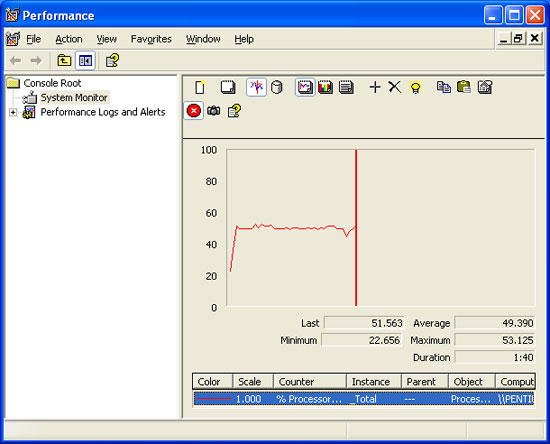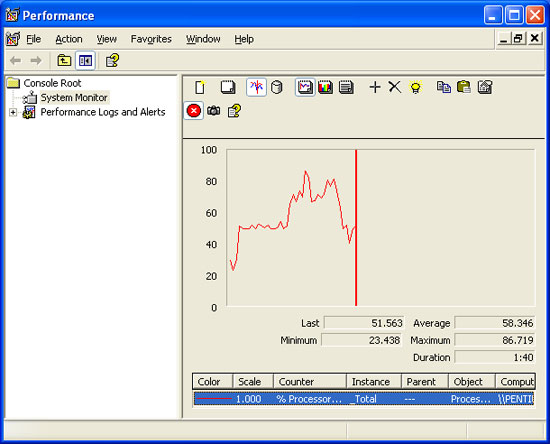Intel's Pentium Extreme Edition 955: 65nm, 4 threads and 376M transistors
by Anand Lal Shimpi on December 30, 2005 11:36 AM EST- Posted in
- CPUs
Multi-core support in Games?
Both Quake 4 and Call of Duty 2 now have SMP support, supposedly offering performance improvements on dual core and/or Hyper Threading enabled processors.
For Call of Duty 2, you simply install the new patch and off you go; SMP support is enabled. To verify, we ran our CoD 2 benchmark and kept a log of the total processor utilization over time. Below is a shot of perfmon with a fresh install of CoD2 (sans SMP patch):
Now, let's look at CoD2 CPU utilization with the SMP patch installed:
We looked at performance at 1024x768 and obviously the higher the resolution, the lesser the impact of a faster CPU (at the same time, the lower the resolution, the greater the impact will be as the game becomes less GPU limited).
To ensure a fair comparison, we tested using the SMP patch and simply disabled SMP manually by setting the r_smp_backend variable to "0". We confirmed that SMP support was actually disabled by running perfmon and measuring CPU utilization.
Surprisingly enough, we actually saw pretty large performance drops in CoD2 with SMP enabled across both AMD and Intel platforms. This is unfortunate, but the withdrawn SMP support of Quake 3 makes it less than shocking. We do expect that things will get better as time goes on.
Quake 4 was a different story; with r_useSMP enabled, we saw some extremely large performance gains with the move to dual core:
The SMP patch either only spawns two threads, or the instruction mix of Quake 4 with the patch does not mix well with Intel's Pentium EE 955. The dual core with Hyper Threading enabled platform didn't do anything at all for performance.
While we're only looking at two games, this is a start for multithreaded game development. You can expect to see a lot of examples where dual-core does absolutely nothing for gaming, but as time goes on, the situation will change.
Both Quake 4 and Call of Duty 2 now have SMP support, supposedly offering performance improvements on dual core and/or Hyper Threading enabled processors.
For Call of Duty 2, you simply install the new patch and off you go; SMP support is enabled. To verify, we ran our CoD 2 benchmark and kept a log of the total processor utilization over time. Below is a shot of perfmon with a fresh install of CoD2 (sans SMP patch):

Now, let's look at CoD2 CPU utilization with the SMP patch installed:

We looked at performance at 1024x768 and obviously the higher the resolution, the lesser the impact of a faster CPU (at the same time, the lower the resolution, the greater the impact will be as the game becomes less GPU limited).
To ensure a fair comparison, we tested using the SMP patch and simply disabled SMP manually by setting the r_smp_backend variable to "0". We confirmed that SMP support was actually disabled by running perfmon and measuring CPU utilization.
| Call of Duty 2 | SMP Disabled | SMP Enabled |
| AMD Athlon 64 FX-57 (2.8GHz) | 80.6 | N/A |
| AMD Athlon 64 X2 4800+ (2.4GHz) | 79.8 | 70.3 |
| AMD Athlon 64 X2 3800+ (2.0GHz) | 78.7 | 68.1 |
| Intel Pentium Extreme Edition 955 (3.46GHz) | 79.8 | 68.4 |
| Intel Pentium Extreme Edition 840 (3.2GHz) | 78.1 | 68 |
| Intel Pentium D 820 (2.8GHz) | 75.6 | 67.1 |
Surprisingly enough, we actually saw pretty large performance drops in CoD2 with SMP enabled across both AMD and Intel platforms. This is unfortunate, but the withdrawn SMP support of Quake 3 makes it less than shocking. We do expect that things will get better as time goes on.
Quake 4 was a different story; with r_useSMP enabled, we saw some extremely large performance gains with the move to dual core:
| Quake 4 | SMP Disabled | SMP Enabled |
| AMD Athlon 64 FX-57 (2.8GHz) | 115.4 | N/A |
| AMD Athlon 64 X2 4800+ (2.4GHz) | 114.9 | 147.4 |
| AMD Athlon 64 X2 3800+ (2.0GHz) | 100.9 | 143.2 |
| Intel Pentium Extreme Edition 955 (3.46GHz) | 98.9 | 142.3 |
| Intel Pentium Extreme Edition 840 (3.2GHz) | 89.0 | 133.6 |
| Intel Pentium D 820 (2.8GHz) | 80.6 | 125.5 |
The SMP patch either only spawns two threads, or the instruction mix of Quake 4 with the patch does not mix well with Intel's Pentium EE 955. The dual core with Hyper Threading enabled platform didn't do anything at all for performance.
While we're only looking at two games, this is a start for multithreaded game development. You can expect to see a lot of examples where dual-core does absolutely nothing for gaming, but as time goes on, the situation will change.










84 Comments
View All Comments
Aenslead - Saturday, December 31, 2005 - link
As J.J., from Spider-Man would say:"Ceap, crap, mega-crap!" and then toss it away.
ElJefe - Saturday, December 31, 2005 - link
well it does move very fast in games. that is nice to see finally.it would be great if the overall power draw numbers were shown as on tomshardware. even there they showed a 90 watt difference between 4800 and the new 65nm. and that wasnt on the oc'd one. The oc'd one showed 150 more watts draw.
Viditor - Saturday, December 31, 2005 - link
Agreed...if it weren't for the X2, this would be an excellent chip by comparison!
Betwon - Friday, December 30, 2005 - link
Now, anandtech begin to learn the truth. There are still many knowledge about CPU that anandtech need to learn.The resluts of tests are simple and clear, but the reasons are complex.
In past years, anandtech took many mistakes about the correct reasons.
bldckstark - Monday, January 2, 2006 - link
You do realize that none of this stuff is very important, right? Both chips work well. Nobody should be criticized for buying either one of them.I love my FIVE computers but making sure my wife and kids are healthy and happy is way more important than any electronic device, especially just one piece of it.
Your damaging and hostile statements are making it appear as if you have forgotten this and the most important thing in the world is that you make all of us geeks think Anandtech is not perfect. News update - WE ALL KNOW THAT! We still like it.
bob4432 - Friday, December 30, 2005 - link
why don't you do the gaming benchmark with bf2 fps unlocked? it appears that it is just hitting its built in lock with both the fx-57 and also P955 EE 3.46 cpus.Spacecomber - Friday, December 30, 2005 - link
I believe that they are using the timedemo feature of the game and that the frame rate max doesn't affect this. It would be nice to see more than just average frame rates reported for games, though. At least a range should be mentioned and maybe a standard deviation.Space
Betwon - Friday, December 30, 2005 - link
We see a test, where the average fps of PD is less than (about 1% - 2%) the fps of AMD's. But PD's fps is more stable than AMD's.In the case that the average fps of netburst is better than the average fps of K8, the test shows that netburst is more stable than K8.
Betwon - Friday, December 30, 2005 - link
The test isn't bf2.bob4432 - Friday, December 30, 2005 - link
any link you could give me on how to do the time demo from within bf2? is this new with the 1.12 patch?thanks